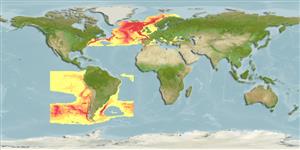Common names from other countries
Classification / Names / Names
ชื่อสามัญ | ชื่อพ้อง | Catalog of Fishes (gen., sp.) | ITIS | CoL | WoRMS
Environment: milieu / climate zone / depth range / distribution range
นิเวศวิทยา
; ระดับความลึก 4 - 5000 m (Ref. 1844). Tropical; 77°N - 56°S, 98°W - 42°E
Southeast Pacific, Atlantic Ocean, Mediterranean and Black Sea.
Length at first maturity / ขนาด / น้ำหนัก / Age
Maturity: Lm ? range ? - ? cm
Trunk slender, unsegmented; lateral processes at least twice as long as their diameters, with very small dorsodistal tubercles and tiny setae. Neck very slender, extending in arc well anterior above proboscis. Ocular tubercle slightly longer than twice its diameter; eyes large. Placed distally, proximal to small apical cone. Proboscis cylindrical, constricted distally. Abdomen tall, slender, with distal setae. Chelifores long, slender, with several dorsal setae; chelae palms rectangular, swollen; fingers slender, without teeth. Ovigers long; third segment more than twice length of second; 2 terminal segments with many setae. Legs long, increasingly setose distally; long dorsodistal spines usually longer than segment diameter; cement gland tube half as long as segment diameter; propodus long, slender, with 2 major heel spines, 4 setae, and long lamina more than half sole length; claw long; auxiliaries tiny but distinct (Ref. 2115, p. 54).
Bathymetrical range; intertidal to abyssal depths (Ref. 2015, page 216). Coastal to slope (Ref. 19). Epibiotic (Ref. 116112). Found on muddy substrate. A carnivore-scavenger (Ref. 96352). Feeds on hosts: Dynamena pumila. It seizes the stems of the hydroid using the apposition of the propodal sole spine and the terminal claws of the legs. Pieces are torn from the hydranth by the chelifores and transferred to the mouth where they are ingested (Ref. 12). Larvae frequently found on Obelia sp. and recorded as well in Clytia hemispherica (Ref. 121217). Feeds mostly at night, avoids touching the hydroid polyps, feeding mostly on the tips of spines (Ref. 121217). It so feeds on Syncoryne eximia (Ref. 12).
Life cycle and mating behavior
วัยเจริญพันธุ์ | การสืบพันธุ์ | การวางไข่ | เซลสืบพันธ์ของเพศเมีย(ไข่) | ความดกของไข่ | ตัวอ่อน
Development site of larval association: galls on Syncoryne eximia; in medusae of Cosmetira pilosella,Turris pileata, Stomotoca dinema, Phialidium hemisphericum and Obelia; and, inside polyps of Hydractinia echinata, Podocoryne carnea and Obelia (Ref. 213).
Raiskii, A.K. and E.P. Turpaeva. 2006. (Ref. 1844)
IUCN Red List Status (Ref. 130435)
CITES status (Ref. 108899)
Not Evaluated
Not Evaluated
Human uses
| FishSource |
เครื่องมือ
ข้อมูลเพิ่มเติม
ชื่อสามัญชื่อพ้องผู้ล่าการสืบพันธุ์วัยเจริญพันธุ์การวางไข่ความดกของไข่เซลสืบพันธ์ของเพศเมีย(ไข่)Egg development
Age/SizeการเจริญเติบโตLength-weightLength-lengthสัณฐานวิทยาตัวอ่อนอุดมสมบรูณ์
แหล่งที่มาจากอินเตอร์เน็ต
Estimates based on models
Preferred temperature
(Ref.
115969): 2.2 - 8.5, mean 3.6 (based on 333 cells).
Price category
Unknown.
